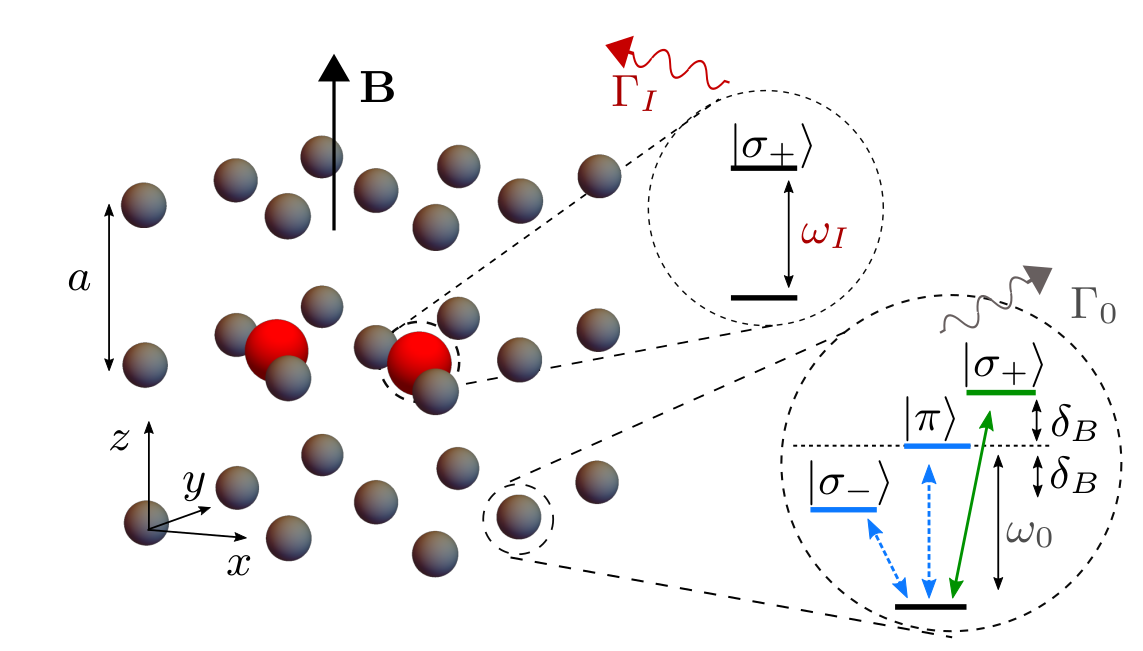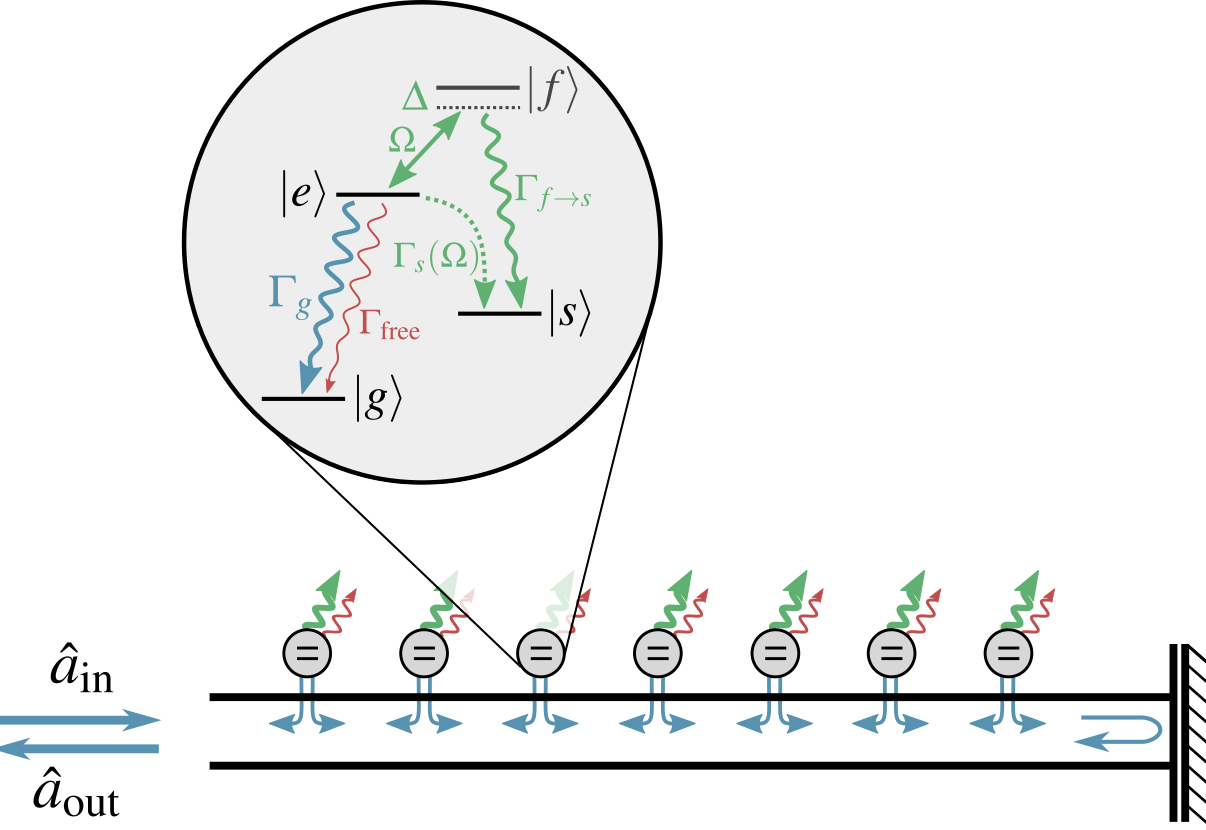Quantum Optics
Table of Contents
Atomic arrays as a photonic media #
Photonic metamaterials are materials structured on the nanometre scale and can coax light into adopting properties it wouldn’t otherwise have. For example, light can be slowed done by many orders of magnitude, made massive, or completely trapped. We can use this to produce tailored interactions between embedded atoms (or atoms brought in close proximity), with many exciting avenues for quantum simulation.
Subwavelength atomic arrays levitated in free space are in some sense the most elementary metamaterial possible, in the simplest case consisting of only a simple cubic array of two-level systems with a dipole transition. We have shown that in one dimension, one can use this insight to explore waveguide QED (i.e., emitters coupled to a waveguide) using just atoms [1]. Something new that is afforded by replacing solid-state nanophotonic structures by atomic arrays is that it is “easy” to make them 3D (already the first ultracold atom Mott insulators were in 3D!). We showed that in 3D atomic arrays can host complete band gaps of light, which would mean that they completely reflect any incident light [2]. This implies that excited impurity atoms placed inside of these arrays no longer decay! This has never been observed in any other system, and we can show that it also enables long-range coherent interactions between the impurity atoms, and can therefore be used to realize the many proposals for quantum simulation with emitters coupled to nanophotonic structures.

- Atomic waveguide QED with atomic dimers
Castells-Graells, Malz, Rusconi, Cirac, PRA (2021), arXiv - Quantum simulation with fully coherent dipole-dipole interactions mediated by three-dimensional subwavelength atomic arrays
Brechtelsbauer, Malz, PRA (2021), arXiv
Photon emission and absorption #
Atoms (few-level systems / superconducting qubits) offer an exceptional level of control over their quantum states. While in free space they typically only interact weakly with each other, the light-matter interaction can be strongly enhanced with suitably confined light modes, such as cavities, waveguides, or subwavelength atomic arrays. With protocols how atomic states and photonic states can be exchanged or entangled, we can use the intrinsic nonlinearity of atoms to measure, control, and generate non-classical states of light.
Under this paradigm, we have shown that a one-dimensional array of atoms coupled to a waveguide (waveguide QED, see figure) makes a robust photon detector [3], and this also inspired us to define a new meterological task that exhibits a quantum advantage [4]. We have also shown that three-dimensional Rydberg arrays can be used to generate entangled photonic states in free space [5]. Note that from this last work sprung an entire research strand on understanding how to prepare tensor network states, which I describe more in detail at state preparation.
Looking more fundamentally at photon emission, we found an analytical solution to Dicke superradiance and proved rigorously that it converges in the limit of large atom numbers [6], which I particularly liked, because it is always nice to say something new about a 70-year-old model that is in every textbook. I am also interested in understanding collective emission in less conventional setups, for example in the presence of retardation [7], squeezing or inhomogeneity [8], or in general non-Hermitian [9, 10], or non-Markovian baths [11–13].
- Unraveling Superradiance: Entanglement and Mutual Information in Collective Decay
Zhang, Malz, Rabl, PRL (2025), arXiv - Nondestructive photon counting in waveguide QED
Malz, Cirac, PRR (2020), arXiv - Weakly invasive metrology: quantum advantage and physical implementations
Perarnau-Llobet, Malz, Cirac, Quantum (2021), arXiv - Generation of photonic matrix product states with Rydberg atomic arrays
Wei, Malz, González-Tudela, Cirac, PRR (2021), arXiv - Large-N limit of Dicke superradiance
Malz, Trivedi, Cirac PRA (2022), arXiv - Effects of retardation on many-body superradiance in chiral waveguide QED
Windt, Bello, Malz, Cirac, PRL (2025), arXiv - Unraveling Superradiance: Entanglement and Mutual Information in Collective Decay
Zhang, Malz, Rabl PRL (2025), arXiv - Anomalous Behaviors of Quantum Emitters in Non-Hermitian Baths
Gong, Bello, Malz, Kunst, PRL (2022), arXiv - Bound states and photon emission in non-Hermitian nanophotonics
Gong, Bello, Malz, Kunst, PRA (2022), arXiv - Efficient tensor network simulation of multi-emitter non-Markovian systems
Papaefstathiou, Malz, Cirac, Bañuls, arXiv (2024) - Optimal two-photon excitation of bound states in non-Markovian waveguide QED
Trivedi, Malz, Sun, Fan, Vuckovic, PRA (2021), arXiv - Convergence Guarantees for Discrete Mode Approximations to Non-Markovian Quantum Baths
Trived, Malz, Cirac, PRL (2021), arXiv

Periodically driven (or measured) optomechanical systems #
Cavity optomechanics concerns systems in which a cavity mode is coupled to a mechanical resonator. The quadratures of a mechanical resonator rotate in phase space with the mechanical frequency, which is why protocols to measure, amplify, or control single quadratures of the mechanical resonator, such as backaction-evading/quantum nondemolition measurements (experiments in Tobias Kippenberg’s lab: [15, 16]), phase-sensitive amplification, or entanglement schemes commonly employ periodically modulated drives. In my PhD, I studied such periodically modulated optomechanical systems. We have rigorously developed a framework to calculate noise spectra in such a situation [13] (my first paper!), and used it to find a closed, exact solution to an optomechanical backaction-evading measurement outside the rotating-wave approximation [14], as well as model several experiments [15–17].

Employing a backaction-evading measurement it is possible to produce a conditionally squeezed mechanical state – essentially, acquiring information about a quadrature X reduces its uncertainty, thus squeezing it. Matteo Brunelli, Andreas Nunnenkamp and I have obtained analytical and numerical results for this case [18]. We later extended our analysis to stroboscopic systems [19].
In fact, our work on nonreciprocal optomechanical system also involves cavities with a modulated drive and some of the techniques developed in Refs [13, 14] were useful there, too (see next section).
- Floquet approach to bichromatically driven cavity optomechanical systems
Malz, Nunnenkamp, PRA (2016), arXiv - Optomechanical dual-beam backaction-evading measurement beyond the rotating-wave approximation
Malz, Nunnenkamp, PRA (2016), arXiv - Floquet dynamics in quantum measurement of mechanical motion
Qiu, et al, PRA (2019), arXiv - Optical Backaction-Evading Measurement of a Mechanical Oscillator
Shomroni, Qiu, Malz, Nunnenkamp, Kippenberg ncomms (2019), arXiv - Two-Tone Optomechanical Instability and Its Fundamental Implications for Backaction-Evading Measurements
Shomroni et al, PRX (2019), arXiv - Conditional dynamics of optomechanical two-tone backaction-evading measurements Brunelli, Malz, Nunnenkamp, PRL (2019), arXiv
- Stroboscopic quantum optomechanics
Brunelli, Malz, Schliesser, Nunnenkamp, PRR (2020), arXiv
Nonreciprocal systems #
There is an ongoing significant interest in nonreciprocal optomechanical devices for photons (and phonons). The motivation for this work comes from the shortcomings of current implementations of directional devices, such as isolators, circulators and directional amplifiers. Such devices are of crucial importance in measurement and communication systems. Conventionally, nonreciprocal devices rely on magneto-optic effects and strong magnetic fields. They are bulky, lossy, and cannot be integrated on a superconducting chip, which makes it difficult to combine them with modern quantum architecture. Moreover, stray magnetic fields due to these devices lead to additional decoherence, which exacerbates the problem.
In collaboration with Tobias Kippenberg’s lab in Lausanne, we have demonstrated an magnetic-field-free optomechanical isolator for photons [18]. The experiment is an optomechanical plaquette, which is a circuit where two cavity modes interact with two mechanical resonator modes (schematically shown below). There are two paths from one cavity to the other, and destructive interference can lead to isolation. Due to the dissipation in the intermediate mechanical modes, photons can still travel in the reverse direction, i.e., the device is non-reciprocal.
This work led on to a proposal for directional, quantum-limited, optomechanical amplifiers, both phase-preserving and phase-sensitive (shown on the right) [19], which shortly after have been realized experimentally by Laure Mercier de Lépinay and Mika Sillanpää at Aalto University. Together with them, we then proposed and implemented a way to obtain nonreciprocity with just one cavity, using virtual cavity Floquet modes [20], inspired by our Floquet framework (picture above).
Inspired by the results in optomechanics, which pertain to bosonic excitations, we have shown that in a similar way, directional transport of fermions can be achieved. Specifically, we proposed to use this mechanism to obtain current rectification in a double quantum dot [21].

- Nonreciprocal reconfigurable microwave optomechanical circuit
Bernier et al, ncomms (2017), arXiv - Quantum-limited directional amplifiers with optomechanics
Malz et al, PRL (2018), arXiv - Nonreciprocal transport based on cavity Floquet modes in optomechanics
Mercier de Lépinay, Ockeloen-Korppi, Malz, Sillanpää, PRL (2020), arXiv - Current rectification in double quantum dot through fermionic reservoir engineering
Malz, Nunnenkamp, PRB (2018), arXiv